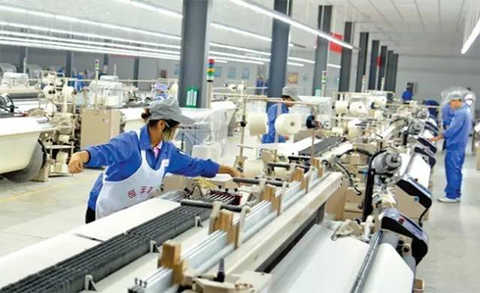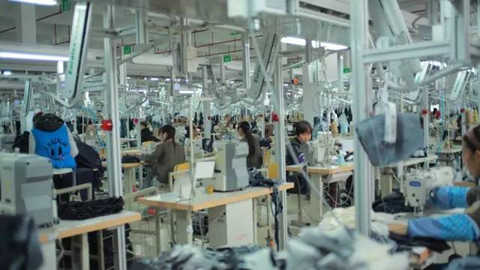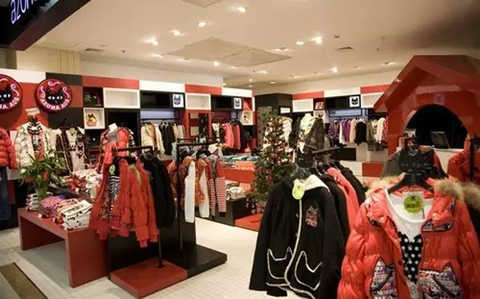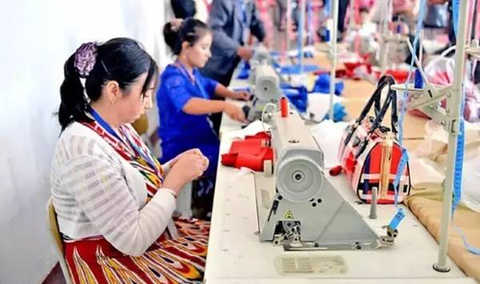Xiaobian said
This is the former Ministry of China Textile Industry retired veteran cadres, Comrade Chen Yi Fang in the "Session Nine Textile Textile power construction Auditorium - Rise of Great Powers textile history," the lecture draft.
The article introduces the early stage of the development of China's textile industry as a leading industry for national industry and China's industrialization, as well as a review of the early development of the textile industry in New China and an explanation of the importance of China's textile industry.
Knowing how to make a difference, knowing what to lose, and reading history with Xiaobian!
"The rise of the textile powers - the 70 years of China's textile industry" was published five times. Please pay attention, welcome to leave a message.
I am very grateful to the former Chinese Ministry of Textile Industry, the retired veteran cadre Chen Yifang and the China Textile Association Party Committee Office.
The rise of textile powers
70 years of China's textile industry
(four)
Chen Yifang
Fourth, fully understand the important position of the textile industry in China's economic and social development, and irreplaceable important role
The textile industry is a large industrial sector. The smooth development and production operation of the textile industry, even to maintain simple reproduction, in addition to raw materials resources, human resources and capital (investment financing), market and other factors, there is also a policy environment, public opinion and environmental issues. The government, the community and the people all value and optimistic about the textile industry. The development of the textile industry will be smooth, even if it encounters some major difficulties.
On the other hand, obviously still developing normally, it is still normal for the economic, social doing an important contribution, but due to urban planning some overcapacity, or not difficult to solve environmental problems, and the marginalized. Many good-end textile factories were “exited†in large and medium-sized cities, “moved out†from the urban area and even in the suburbs, and moved to areas and lots that did not have the conditions for the survival and development of textile and clothing enterprises.
Obviously there are social needs, and have a good industrial base ramie textile, linen textile, tussah silk and other traditional textiles, agricultural policies in recent years, but due to the ill-considered, caught in a dilemma complete industry-wide downturn should not have happened. The jute textile industry is extruded into the market by polypropylene fabrics, which is caused by the market law. However, from the economic development policy of “green developmentâ€, it is not appropriate to save the jute textile and jute planting industry.
The textile industry is an important sector in China. The textile system is not powerless in the policy environment and public opinion environment of the textile industry. But first of all, our textile industry "people in the industry" must fully understand the status and role of the textile industry in China's economic and social development. We must talk about the importance of the textile industry with confidence, and talk about the economic and social interests of the rise and fall of the textile industry.
In the past, the old minister of Qian Zhiguang did this. We want to inherit this style and working methods.
The so-called full understanding of the status and role of the textile industry in China's economic and social development, concentrated on one point: the textile industry is China's pillar industry. The “first 30 years†after the founding of the People’s Republic of China were the same, and so was the “last 30 yearsâ€.
Since the beginning of the 21st century, in the information industry, energy industry, automobile manufacturing, construction machinery manufacturing, electrical machinery industry, household electrical appliance industry and construction industry, transportation industry has taken off, it has become a "traditional industry" of metallurgy, machinery Industrial sectors such as chemical, building materials, textiles and mining are still the pillar industries of China.
The reason is simple: China's economy, the continued development of society, Lide Kai steel, cement, machine tools, motors, three acid two alkali, fertilizers, chemical fiber, cotton yarn, cotton cloth, paper, plastics and other industrial products, the most basic right? Be able to leave the real economy sector of "state revenue", "national reserves", "social jobs" as well as "GDP" do? The status of these important industrial sectors in the "pillar industry" of China's economy and society is not selected by an authoritative organization, nor is it promoted. It is based entirely on the authoritative statistics of the National Bureau of Statistics and is determined by “numbers and factsâ€.
It is quite regrettable that in the late 1990s, when the textile industry experienced a new round of development in the early stage of reform and opening up, it was necessary to make some adjustments to certain production capacity and industry structure and product structure. , newspapers and magazines, etc.) The paradox of the Chinese textile industry has become a "sunset industry." In the textile industry, people often lack understanding of the textile industry as a whole, and people are still wondering whether China's textile industry is still a pillar industry. Is it already in the footsteps of the textile industry in some old industrial countries, it will gradually decline and become a declining "Sunset industry" doubts.

The so-called "sunset industry" cloud, of course, has a negative impact on the development of the textile industry. Even after the “great adjustment of the textile industry†in the last three years of the last century and the rapid resurgence of the textile industry, the negative impact of the so-called “sunset industry†theory has not been completely eliminated.
For example, some large and medium-sized city governments that had been awarded the best for the construction of approved textile enterprises no longer pay attention to the textile industry. Even some good-end textile and garment factories have unintentionally let "exit the city circle." Even allowing some financial institutions that lacked foresight to arbitrarily cut off the capital chain of textile factories that are operating normally, these factories are quickly in a desperate situation. Some new textile industry bases that were hard to build in the 1950s and 1960s have also suffered from such a policy environment and public opinion environment, and some have even disappeared from the Chinese economic map. From the misleading public opinion to the policy mistakes to the textile industry production and construction, the negative impact is so direct and clear.
Let's talk about the "numbers and facts" of 2000-2015 to analyze positively that "the textile industry is still the pillar industry of China's economic and social development."
1. Under the new situation that China has developed into the world's second largest economy, the textile industry remains one of the most important components of China's national economy.
1 The number of enterprises above the scale of the textile industry (2000-2010 is an annual sales income of more than 5 million yuan, and after 2011, more than 20 million yuan), from 19,400 in 2000 (accounting for 11.9% in "national industry") It has grown to 54,000 in 2010 (12% of the national industry). In the case of the “standards on the enterprise†division standard changed to 20 million yuan, the number of enterprises above the scale of the textile system in 2014 was 39,300, accounting for 10.9% of the “national industry†of 378,000.
2 The main business income of the textile industry. In 2000, it accounted for 9.9% of “National Industryâ€. Since then, with the rise of a large number of emerging industries, the proportion of the textile industry in the “national industry†has dropped reasonably to 6.1% in 2014. However, the absolute number and the vertical contrast of the textile industry itself are extremely impressive. In the fifteen years from 2000 to 2014, it grew from 83.39 billion yuan to 676.61 billion yuan, a seven-fold increase. It is a "big development" situation.
3 The total profit and tax of the textile industry. In the fifteen years from 2000 to 2014, it grew from 60.2 billion yuan (4.5% in “National Industryâ€) to 602.9 billion yuan, a nine-fold increase. The proportion in “National Industry†increased slightly, maintaining a level of around 5%.
â‘£ textile, garment total exports (customs caliber). From $53.044 billion in 2000, the grade rose to $306.96 billion in 2014. The proportion in “National Industry†dropped from 21.3% to 13%; the absolute value of exports was a substantial increase, ranking first in “National Industryâ€. Especially in the very valuable “trade surplusâ€, it has contributed a lot to the country (please refer to Schedule 2).

2. Successfully shouldered the responsibility of “guaranteeing and improving the consumption of clothing for nearly 1.4 billion people in the country†in the construction of “all-round well-offâ€, and has upgraded the consumption of Chinese society to the level of some developed countries in Europe. .
In the 16-year period from 2000 to 2015, cotton fabric production increased from 27.7 billion meters to 89.3 billion meters, a record high in the world;
Silk fabrics (including silk and chemical fiber filament fabrics) have grown from 4.69 billion meters to 43.92 billion meters (62 billion meters of silk and 43.3 billion meters of chemical fiber filament fabric);
Wool fabrics have grown from 280 million meters to 630 million meters;
Ramie/linen fabrics have grown from 120 million meters to 880 million meters.
The total fabric production increased from 32.79 billion meters to 134.74 billion meters. This does not include wool (production of 405,000 tons in 2015) and “knitted fabrics†(only 10.9 billion meters in direct export in 2015), knitwear (in 2015, only “regular enterprises†produced knitwear worth 14.4 billion Pieces).
In 2015, the total output of cotton, wool, hemp, silk and chemical fiber fabrics (that is, the supply of textiles) was 134.74 billion meters. What kind of commodity supply concept is it?
According to the national population calculation in the same year, the annual output of “per capita†fabric has reached 98 meters. If the vertical comparison is made in absolute terms, this is roughly 52 times of the total production of cotton, wool, hemp, silk and chemical fiber fabrics in China's textile industry in 1950 (about 2.6 billion meters); in general, it is the "cancellation of cloth tickets" in Chinese society. On the eve, the total production of cotton, wool, hemp, silk and chemical fiber fabrics produced in 1983 (about 17.6 billion meters) was 7.7 times! In the year of 2015, in the total output of 134.74 billion meters, the direct export of various types of fabrics (about 20.5 billion meters) and indirect exports after processing into clothing and home textiles (from 40 million meters in width) to the domestic market. The total amount of fabrics is at least 74 billion meters, or about 54 meters per capita (not including a large number of knitted fabrics).
Economic statistics and common sense of life tell us that when the total supply of cotton, wool, hemp, silk and chemical fiber fabrics per capita (person/year) reaches 30 meters in one year, the clothes of a country’s people are already quite Wealthy. Achieving about 50 meters is actually a "higher level of well-off" consumption level (please refer to Schedule 3).
The main role of the textile industry in the construction of "a comprehensive well-off society" in Chinese society is real and clear.

3. Important factors for maintaining and improving the level of prosperity in the urban and rural markets.
In the fifteen years from 2000 to 2014, China’s “total retail sales of consumer goods†grew from 3.9 trillion yuan to 27.2 trillion yuan, an increase of nearly six times. The textile industry is the most important consumer goods industry sector. As the main “supply side†of urban and rural consumer goods in China, it plays an important role in raising the level of “the total retail sales of consumer goodsâ€.
With the increase and diversification of the consumption demand of urban and rural households, the proportion of “clothing expenditure†in the total retail sales of social consumer goods in China has gradually decreased from 20-30% in the 1950s and 1960s to around 15% and 10%. about. However, the absolute number and per capita level of “clothing expenditure†increased significantly during the fifteen years from 2000 to 2014.
The “clothing expenditure†of urban households has increased from 500 yuan to 1,627 yuan in 15 years.
The “clothing expenditure†of rural households has increased from 96 yuan to 510 yuan in 15 years.
Any explanation for the textile industry as a “pillar industry†is superfluous in maintaining and improving the level of commodity supply in the urban and rural markets.

4. Important stability factors for social employment and social employment.
Since the beginning of the 21st century, with the textile industry accelerating the modernization of equipment and technology and greatly increasing labor productivity, the number of employees of textile systems above designated size has increased slightly from 7.585 million in 2000 to 9.75 million in 2014. (10% of the "National Industry" 97.72 million people).
Contemporary Chinese textile industry, had not had the "Labor-intensive industries" within the meaning. However, starting from the national conditions, the textile system has not pursued one-sided pursuit of "provincialization." On the contrary, in the overall situation of steady development, the number of employees in the entire textile industry system has increased slightly, reaching a huge scale of nearly 10 million people. In addition, a large number of middle, small and micro-enterprise employees gathered in the textile and garment industry cluster /professional market across the country, the number of employees in the textile industry with the “wide society†statistics has been stable at around 21 million in recent years.
If we consider the cotton-growing industry, the sown-and-yellow industry, the sheep-raising industry, the sericulture business, and the textile, clothing and commerce businesses that are complementary to the textile industry, the total number of employees in the textile industry will be “one glory and prosperity†in stabilizing the employment level of Chinese society. It is even more important.
In short, during the decade of 2000-2015, China's textile industry has seen a new round of development. The status of the textile industry in the "pillar industry" in China's economic and social development is generally clearer. The so-called "sunset industry" cloud is really over-considered.

It has the characteristics of lightness, comfort, easy-care, fashion and reasonable price.
Over 20 years growth, the company has cultivated a team of experienced technical and management staff and owned the modern facilities and automatic assembly lines from dyeing, knitting, finishing and deep processing.
Meanwhile, the company always follows the fashion steps, continuously innovates and develops new products, and improves the management and service ability.
The upscale faux fox fur and knitting wool products reach the domestic and international high level. Products have been exported to the United States, Australia, Japan, Russia and Vietnam. In addition, according to the report from international accredited testing institutions, the test of formaldehyde in some products is ND level. The company receives high praise from the international specialists.
Faux Fur,Yarn Knitting Fur,Brushing Fake Fur,Brushing Faux Fur
Wuxi Shuanglida Plush Technology Co., LTD , https://www.sd-fauxfurs.com